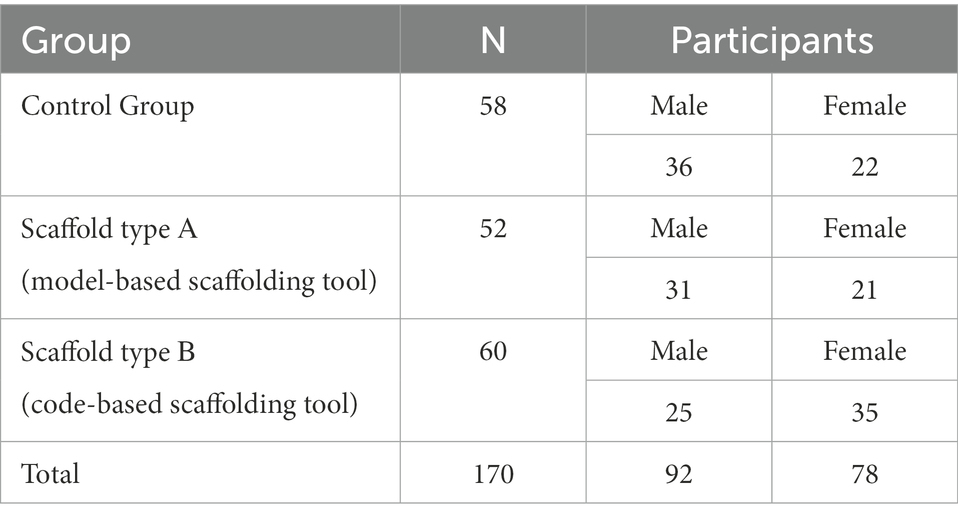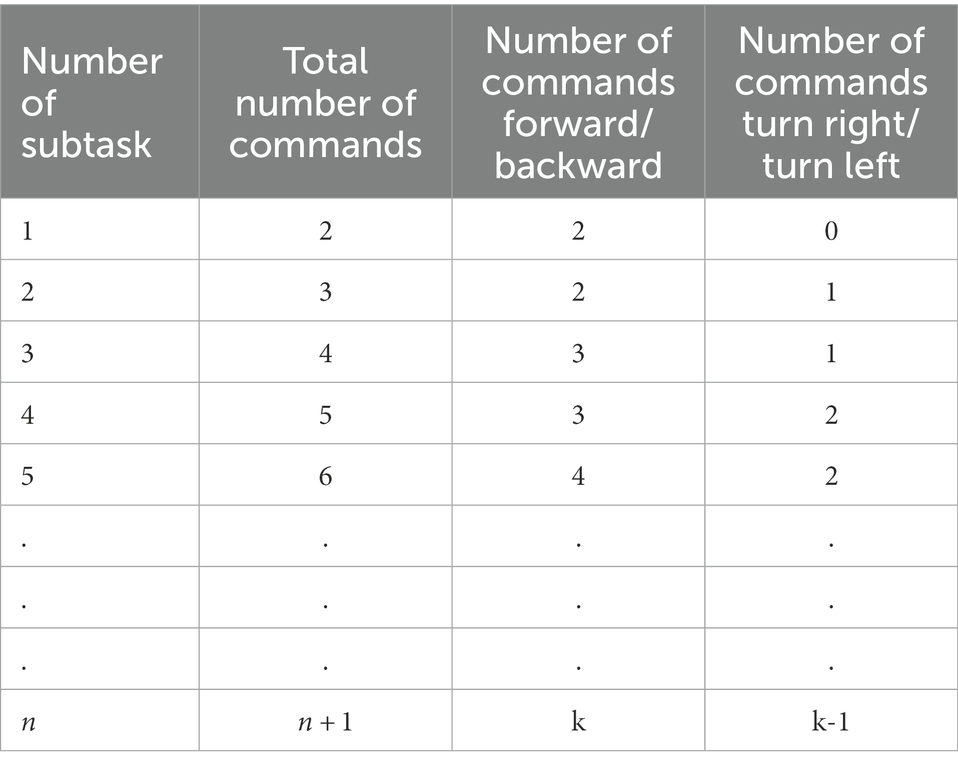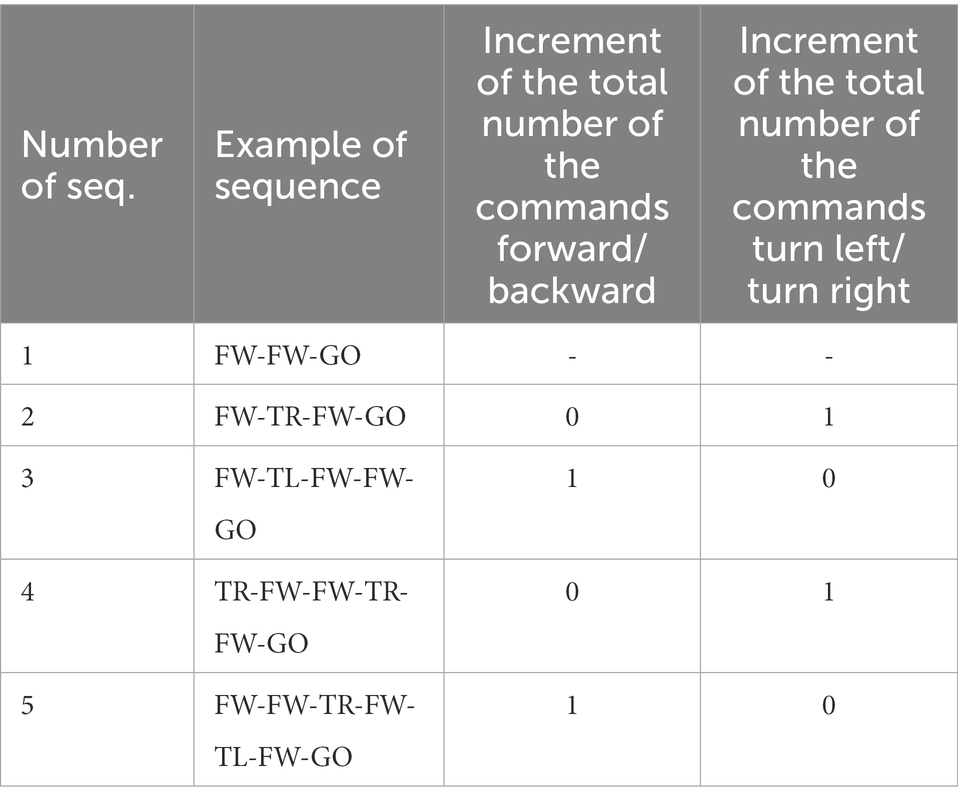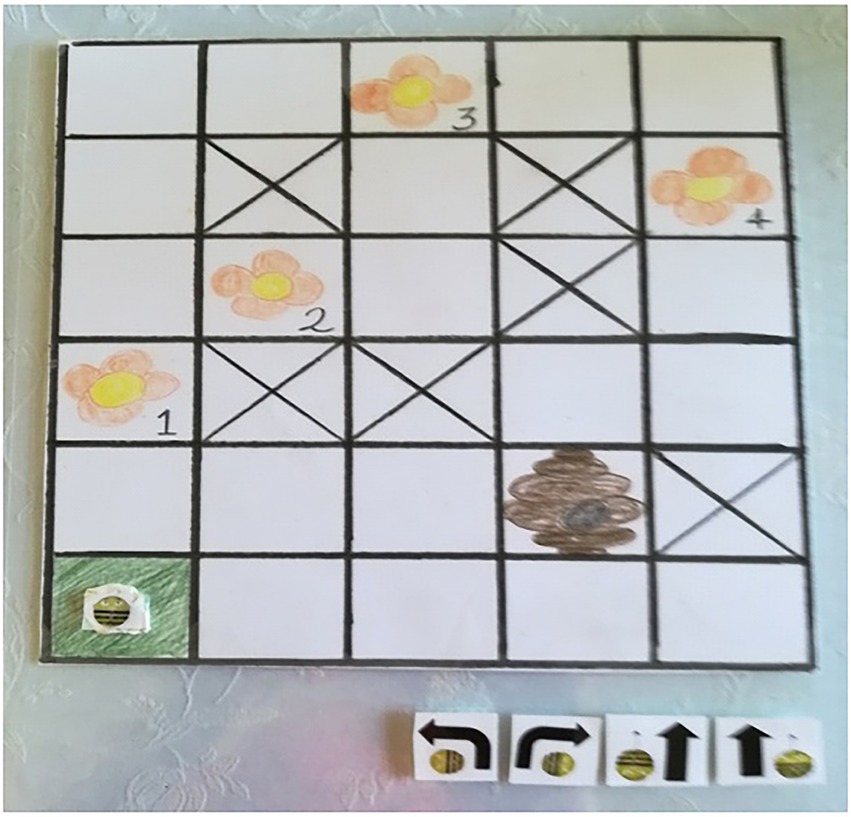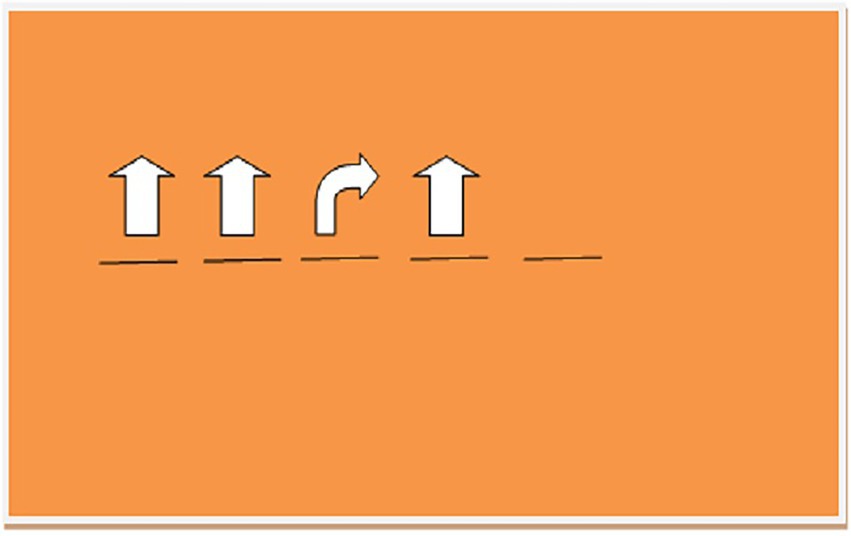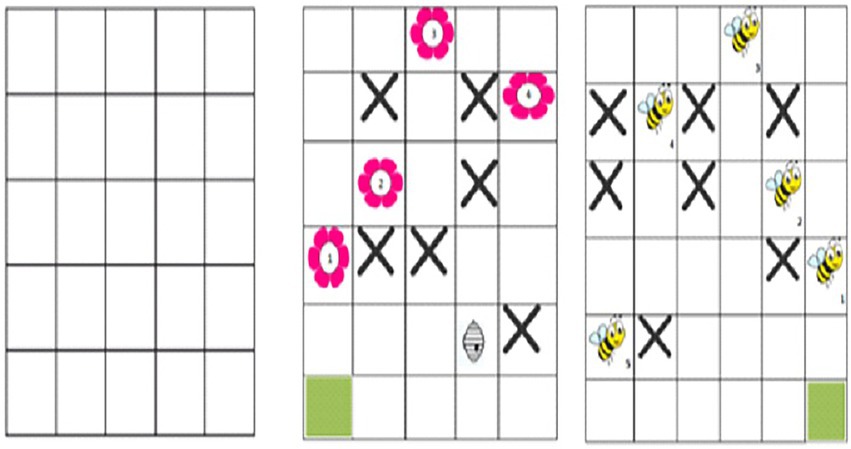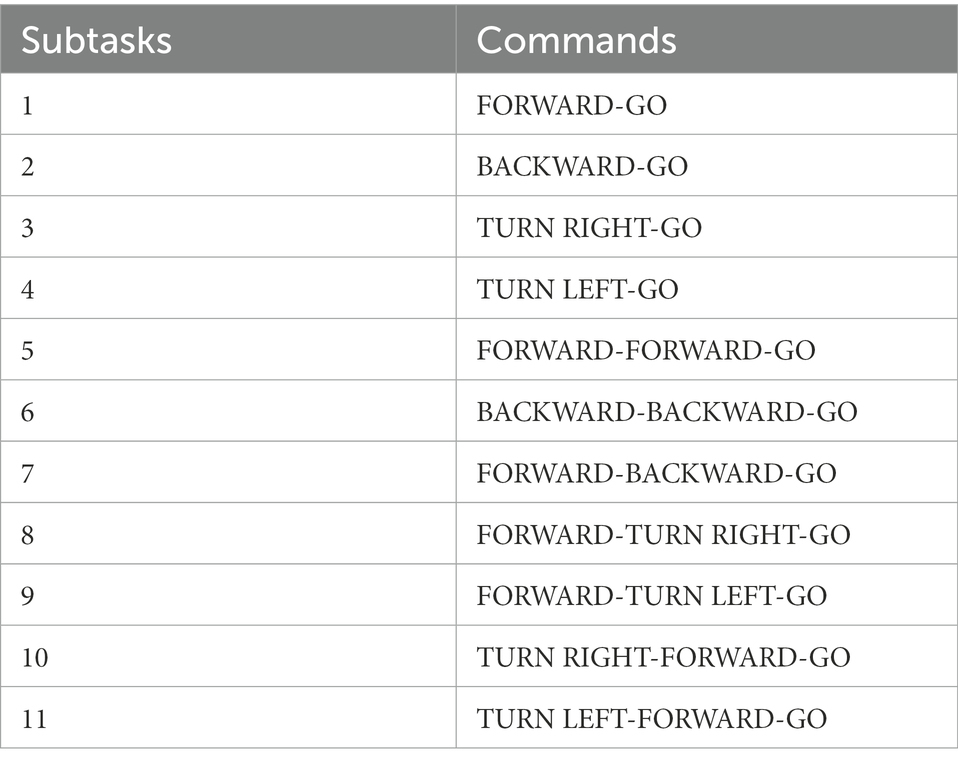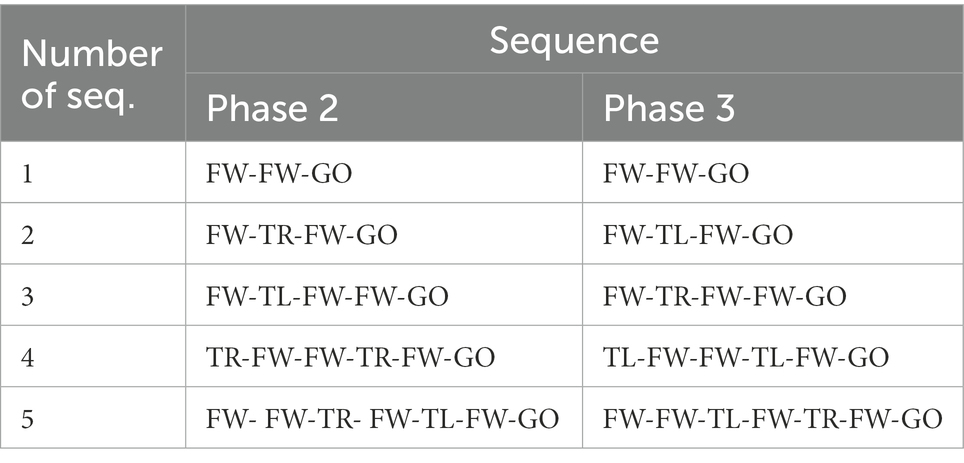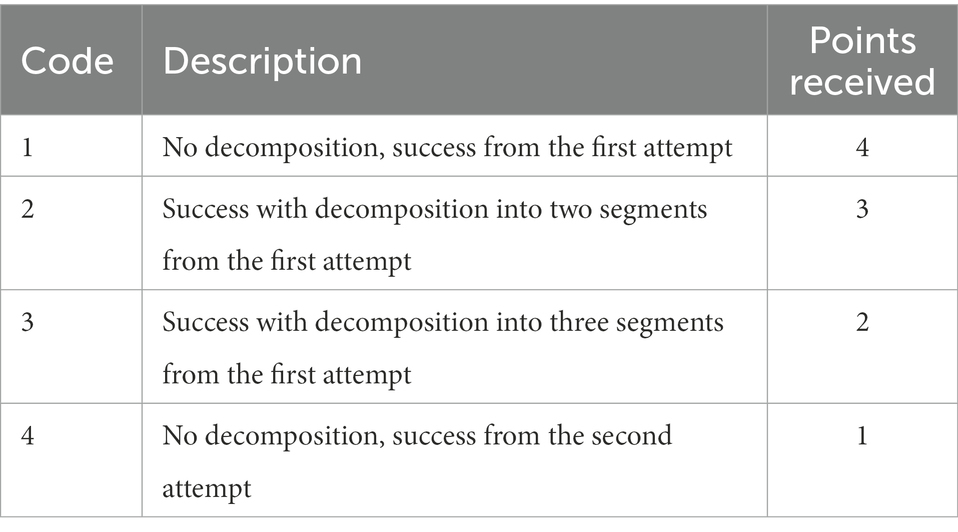- Department of Education, University of Cyprus, Nicosia, Cyprus
The research community has embraced computational thinking as an essential skill to develop in school and academic settings. Many researchers argue that computational thinking should be developed in the context of programming and robotic activities in all educational levels of education, starting from early childhood education. However, the factors related to developing computational thinking in preschool education are still under study. Furthermore, not too many empirical investigations provide evidence about the development of computational thinking in young children. The present study examined the effects of scaffolding and gender in developing young children’s sequencing and decomposition skills - two of the five skills that constitute computational thinking. The results indicated statistically significant effects about the type of scaffolding on children’s computational thinking in favor of the children assigned to the experimental groups. Lastly, boys outperformed girls on all occasions, indicating that gender effects exist. The authors conclude that researchers need to design teaching interventions in such a way so they have mathemagenic outcomes for all learners irrespective of gender. Finally, the authors conclude with implications and future research directions.
1. Introduction
Computational thinking is a core concept emerging from the principles and practices of the discipline of computer science and is an essential skill for the workforce of the 21st century (Wing, 2011; Sengupta et al., 2013; Fluck et al., 2016). It consists of several thinking skills applicable in different disciplines, focusing on problem-solving (Guzdial, 2008). Research shows that engaging children early in computational thinking activities can develop a more profound understanding of STEAM topics and computing concepts (Sengupta et al., 2013; Wilensky et al., 2014). STEAM (Science, Technology, Engineering, Arts, and Mathematics) is an educational approach that uses science, technology, engineering, the arts, and mathematics to guide student inquiry, dialogue, and critical thinking during solving problems. Unfortunately, today there is a severe shortage of human resources in the STEAM areas, and the number of students choosing STEAM courses is experiencing a declining trend (Adams Becker et al., 2016; Bocconi et al., 2016; Genkova and Schreiber, 2021).
Researchers have argued the importance of promoting the development of computational thinking in all levels of education, including early childhood education (Wing, 2006; Barr and Stephenson, 2011; Grover and Pea, 2013; Smith and Burrow, 2016). However, although empirical studies studied the development of computational thinking in elementary and high school settings, research in the development of computational thinking in preschool education is still in its infancy (Bers et al., 2014; Angeli and Valanides, 2020).
Examining the current literature reveals that educators use robotics activities to teach computational thinking in early childhood education (Bers et al., 2014; Angeli and Valanides, 2020). Furthermore, the studies undertaken during the last decade show that the active manipulation of various robotics tools can enhance children’s learning experience (Ching et al., 2018). In addition, the use of robotics can advance the development of cognitive skills (Papert, 1980; Bers et al., 2014), social skills (Clements, 1999; Sullivan and Bers, 2013), engineering and design skills (Druin et al., 2000; Bers, 2008), and in general children’s mental growth (Horn et al., 2012). Therefore, programming within the context of robotic activities can support the development of children’s computational thinking skills (Papert, 1980; Resnick et al., 2005; Grover and Pea, 2013; Lye and Koh, 2014).
In this study, the authors designed and developed scaffolds for teaching young children how to program a low floor (i.e., easy to learn how to use) robotic device to perform particular tasks. The study also investigated the effects of gender on learners’ computational thinking. Consistent findings in the literature support the claim that gender differences influence students’ learning in STEAM activities (Pomerantz et al., 2002; Duckworth and Seligman, 2006; Sousa and Tomlinson, 2011). In particular, research findings in neuroscience show that the female and male brains have morphological variances resulting in more cortical areas devoted to verbal functioning for females and visual–spatial information processing for males (Baron-Cohen, 2004; Halpern et al., 2007). Consequently, girls are better at lingual and sensory memory tasks, and boys at visual memory tasks (Bonomo, 2010). Therefore, research findings show that girls perform better in complex reading and writing tasks, whereas boys in mental rotation tasks (Linn and Petersen, 1985; Voyer et al., 1995; Maeda and Yoon, 2013). However, these gender differences have not been examined within the context of learning with robotic devices and thus this research study will be the first one to trial gender differences using Bee-Bots.
Regarding scaffolding, it is well documented in the literature that the use of scaffolding is essential to improve learning, primarily when the learning process encompasses technological tools (Azevedo and Hadwin, 2005; Angeli and Valanides, 2020). Moreover, scaffold provision, as it will further discussed in section 2.5. Scaffolding, is of great importance, especially for the learning of young students since in its absence, young learners may fail to complete a task (Henderson et al., 2002; Chen et al., 2003; Rodgers, 2005; Mashburn et al., 2009; Van de Pol et al., 2010; Belland, 2014). Accordingly, the authors investigated the interaction effect between gender and the type of scaffolding. In addition, they sought to examine whether different types of scaffolding differentially affected the development of boys’ and girls’ computational thinking.
2. Theoretical Background
2.1. Computational thinking
In the early days, computer scientists conceptualized the computer as a tool for science and a new way of thinking (Von Neumann, 1988; Denning, 2017). Recently, researchers showed a vital interest in computational thinking after Wing published her seminal article on the importance of computational thinking in 2006. Specifically, in her article, Wing (2006) clearly explained the interconnection of computational thinking with many disciplines. Recently, research efforts emphasized the importance of introducing computational thinking in all scientific fields (Weintrop et al., 2016), literature (Burke and Kafai, 2012), arts, and music (Edwards, 2011). Additionally, among many other researchers, Grover and Pea (2013), Smith and Burrow (2016), and Yadav et al. (2016) strongly argued for the systematic integration of the teaching of computational thinking in school curricula.
Computational thinking is a problem-solving process that educators can use in all content areas across grade levels (Barr and Stephenson, 2011; Román-González et al., 2018). In particular, computational thinking, as a problem-solving process, refers to how to (a) formulate problems with the use of a computer, (b) organize data using abstractions, (c) automate solutions using algorithms, and (d) generalize a solution to other issues.
Currently, there is no universal definition of the construct of computational thinking (Angeli et al., 2016; Kalelioglu et al., 2016). Weinberg (2013) reported that 25% of published articles on computational thinking cite their different definitions. Since a review of all computational thinking definitions in the literature is out of the scope of this study, the authors adopted the well-accepted definition offered by Grover and Pea (2013). According to Grover and Pea (2013), abstraction is the skill of removing characteristics or attributes from an object or entity to reduce them to a set of fundamental elements. Abstraction and generalization have similar meanings as abstracts are generalized through parameterization. Decomposition involves breaking down complex problems into simpler ones. Algorithmic thinking involves devising a step-by-step solution to a problem and differs from coding (i.e., the technical skills required to write code in a programming language).
Additionally, algorithmic notions of sequencing and control flow are also considered essential elements of computational thinking. Finally, debugging is about recognizing when actions do not correspond to instructions, and fixing errors in a sequence of instructions. In this study, the authors examined two of the five aspects of computational thinking: algorithmic thinking focusing on sequencing; and the skill of decomposition.
2.2. Robotics
Robotics engage children in a playful exploration of tasks aligned with developmentally appropriate practices for early childhood education (Bers, 2008). Additionally, play improves children’s ability for creativity and mental flexibility. In robotics, the manipulation of physical objects enables children to exercise their symbolic thinking and combine their ideas to generate motor responses (Fenson and Schell, 1985; Russ, 2004; Singer and Singer, 2005; Critten et al., 2022).
Piaget (1963) was the first to conceptualize that the manipulation of physical objects plays a significant role in the learning of all children. Specifically, according to Piaget (1963) and Bredekamp and Copple (1997), children realize the world that surrounds them by dynamically exploiting the objects that constitute it. In this regard, hands-on experiences enable children between five and 6 years of age to form a connection between a concrete representation (e.g., authentic materials) and a symbolic representation (e.g., abstract material, such as ideas; Clements and McMillen, 1996).
Accordingly, in this context, technological tools, like floor robots, can offer children a hands-on way of acquiring new knowledge (Papert, 1993; Reid-Griffin and Carter, 2004; Chaldi and Mantzanidou, 2021). Furthermore, Resnick (1995) states that the best computational tools are the ones that provide the learner with the affordance not only to comprehend the learning content but to transform it and apply it to new concepts and ideas.
Thus, learning with robots can be an attractive activity for young learners in early childhood education settings (Nouri et al., 2020; Chaldi and Mantzanidou, 2021). Children at 4 years old can develop computational thinking skills when they play with robots to solve a problem (Papadakis et al., 2017). Specifically, researchers reported in the literature that learning with robotic devices allows learners to engage in experimentation, research, programming, and problem-solving about things they encounter in their daily lives (Pugnali et al., 2017). Kim et al. (2015) indicate that the contact and use of educational robots in education are significant and influential in teaching STEAM as robotic devices offer opportunities for young children to experiment with knowledge-building activities (Falloon, 2016; Vidakis et al., 2019; Papadakis, 2020). Especially, Falloon (2016) stated that young learners learn to code through decomposition, problem analysis, and evaluation activities.
Accordingly, in the study, the authors used the floor robot Bee-Bot to engage preschool children in various activities to solve several tasks.
2.3. Bee-Bots
Prior research has shown that four-year-old children can successfully build and program a robot (Bers et al., 2002; Cejka et al., 2006; Wyeth, 2008; Sullivan and Bers, 2013). In addition, researchers have used Bee-Bots in research studies with impressive learning outcomes in developing children’s problem-solving skills (Bers et al., 2014; Elkin et al., 2016). The Bee-Bot is a small floor programmable robot in the form of a bee (Elkin et al., 2016). In addition, it is a screen-free coding toy robot that allows children to interact with it without the constraint of screen-time (Livingstone, 2016).
A Bee-Bot uses a LOGO-like programming language with simple programmable steps. It is a robotic device that is developmentally appropriate for preschool children (Beraza et al., 2010; Highfield, 2014). A Bee-Bot has four directional buttons placed on its back (see Figure 1), and children can program it to move forward or backward, turn left or right by 90 degrees, clear its memory, pause, and execute a sequence of commands (Highfield, 2014).
A Bee-Bot does not need additional hardware to work. Also, the large variety of floor mats used with Bee-Bots accommodates educators with many possibilities for designing lessons on different topics and learning objectives. However, a Bee-Bot lacks the support of the algorithm’s visualization imposing an extraneous cognitive load on learners’ mental resources (Angeli and Valanides, 2020). Therefore, teachers need to scaffold young children’s learning during their interactions with Bee-Bots by using appropriate tools that can act as external reference systems for reducing children’s cognitive load during problem-solving (Sarama and Clements, 2009; Angeli and Valanides, 2020). Accordingly, to remedy Bee-Bots’ shortcomings, the authors of this study designed and implemented scaffolding tools for supporting young children’s problem-solving with Bee-Bots.
2.4. Programming
Papert (1980) strongly supported the view that the concepts of robotics and programming are intertwined. Learners, through interplaying with robotics, develop an understanding of elementary programming concepts, such as sequence and cause-and-effect relationships (Fessakis et al., 2013; Kazakoff et al., 2013), as well as an understanding of more advanced concepts, such as abstraction, debugging, and iteration (Horn and Jacob, 2006; Wing, 2008; Brennan and Resnick, 2012; Horn et al., 2012). Papert (1980), in his seminal book “Mindstorms: Children, computers and powerful ideas,” documented the manifestation of the programming language as a learning tool for the development of problem-solving and reflective thinking. Through programming, children learn to solve problems systematically and express ideas using various tools (Sullivan and Bers, 2013). In particular, programming as a teaching approach can foster cognitive tasks directly linked to the development of computational thinking (Resnick et al., 2005; Grover and Pea, 2013; Lye and Koh, 2014; Macrides et al., 2022).
According to the Macrides et al. (2022), programming can be introduced to young learners as a stand-alone subject matter or integrated into the regular kindergarten curriculum with other subject areas such as music, movement and dance, art, science, mathematics, and literacy. In addition, recent advances in visual language-based systems using digital, tangible, or hybrid media have enabled the introduction of programming and computational thinking concepts and ideas in early-childhood education settings (Elkin et al., 2016; Bers and González-González, 2019). At the same time, research evidence shows that programming synergistically deepens the learning of STEAM subjects and that its teaching should start as early as possible in school at all educational levels and ages (Sengupta et al., 2013; Wilensky et al., 2014). Relevant review studies also supported that computer programming through robotics can be a promising educational tool for integrating technology and engineering in early childhood STEAM education (Jung and Won, 2018; Çetin and Demircan, 2020).
2.5. Scaffolding
Wood et al. (1976) defined scaffolding as the support provided to learners by their educators in the correct quantity and time, enabling them to participate in a problem’s solution substantially. The construct of scaffolding is directly associated with the socio-cultural theory of Vygotsky (1978) and, more specifically, with his idea of the zone of proximal development. The zone of proximal development is “the distance between the actual development level as determined by independent problem solving and the level of potential development as determined through problem-solving under adult guidance or in collaboration with more capable peers” (Vygotsky, 1978, p. 86). Research studies report that scaffolding in the form of instructional support can use tools, strategies, computer tutors, and animated pedagogical agents to assist learners in comprehending and conceptualizing meanings emerging during teaching beyond their current mental and cognitive capabilities (Puntambekar and Hubscher, 2005).
Providing scaffolding is essential in educational settings because it can positively affect the teaching and learning process (Hogan and Pressley, 1997; Cole, 2006; Pawan, 2008), especially for young students (Belland, 2014). Originally, instructional scaffolding referred to the support or guidance provided by a human expert to a novice learner to complete a task that would otherwise be too challenging to achieve beyond the learner’s unaided efforts (Belland, 2014; Kim et al., 2018). However, due to the advancements of technology, scaffolding is no longer limited in interactions between a human expert and a learner; instead, such interactions now include the use of technological tools, resources, and environments (Cai et al., 2022). When learners’ limited cognitive resources are sufficiently supported and augmented by scaffolding, they can concentrate on and master the task at hand by completing only those elements within the range of their competence (Tawfik et al., 2018). Importantly, learners become genuinely involved with the mission to be achieved only when provided with appropriate help or a supporting structure to initiate and sustain interest (Belland et al., 2019). Subsequently, while the learners’ competence gradually increases, assistance is withdrawn, and learners continue to function independently. However, removing the aid does not diminish learning or functioning; learners operate at the elevated plane reached via scaffolding (Liu et al., 2020).
2.6. Gender
Consistent findings in the literature support the claim that gender differences influence student learning and school achievement (Pomerantz et al., 2002; Duckworth and Seligman, 2006; Sousa and Tomlinson, 2011). For example, studies in neuroscience (Bonomo, 2010; Sousa and Tomlinson, 2011) reported that the hippocampus, the brain structure where memory and language function, develops more rapidly and is more prominent in size in girls than boys. This fact causes differentiation in sequencing, vocabulary, and reading and writing skills between the sexes. In addition, the cerebral cortex, responsible for spatial perception, is more significant in boys than girls, supporting that boys learn better with visual-motor activities. Because of these differences, girls tend to be more social and prefer group-centered activities than boys, who like personalized and sensory-motor activities (Gurian and Ballew, 2003).
Research on gender disparity in acquiring computational thinking skills in robotics activities is relatively sparse in educational settings. While research has been conducted on gender differences with elementary and high school students (e.g., Atmatzidou and Demetriadis, 2016; Román-González et al., 2017), limited research has been carried out in early childhood settings (Sullivan and Bers, 2013; Atmatzidou and Demetriadis, 2016).
3. Research purpose
The present study sought to investigate whether gender and scaffolding affected preschool students’ computational thinking performance in the context of problem-solving activities with Bee-Bots and whether the scaffolding used differentially affected boys’ and girls’ computational thinking.
4. Materials and methods
4.1. Participants
One hundred and seventy young children aged between five to 6 years old participated in the study. Children were randomly selected from 10 different preschools in a European country. Parents signed consent forms for children’s participation in the study. There were 78 girls and 92 boys. Participants were randomly assigned into three research groups, two experimental groups, and a control group, as shown in Table 1. In the first experimental group, children used the model-based scaffolding technique; in the second experimental group, they used the code-based technique. The authors explain both types of scaffolding in sections 4.3. Research intervention for phase 2: Model-based scaffold and 4.4. Research intervention for phase 2: Code-based scaffold. In the last group, the control group, children worked through play with no scaffolding. All research phases were conducted at the site of each school individually with each child because scaffolding tools are exceptionally efficient in individualized learning environments (Tabak, 2004; Puntambekar and Kolodner, 2005). The same researcher completed all of the tasks with the children.
4.2. Research intervention for phase 1
During the first phase of the intervention, children in all three groups became familiarized with the essential functions of Bee-Bots, followed by learning complex programming commands. The structure of each lesson was designed based on the theory proposed by Hubwieser and Aiglstorfer (2009), which approaches the teaching of programming into two parts: the learning of basic process units and the teaching of combined process units. In this study, the basic process units corresponded to the primary sequences of the Bee-Bot’s commands, taught in 11 subtasks, as shown in Table 2. This approach has many benefits as novice programmers (a) are successfully introduced to basic programming commands (Misirli and Komis, 2014), and (b) learn to program successfully even during their initial attempts (Reges, 2006).
The combined process units consisted of complex and more extensive sequences of commands. For learning these sequences of commands, the authors adopted the principles reported by Armoni and Gal-Ezer (2014). In line with their work, the problem-solving tasks consisted of subtasks with increasing levels of complexity. More specifically, the total number of the commands FORWARD/BACKWARD and the total number of the TURN_RIGHT/TURN_LEFT commands increased gradually and were used in various combinations, as shown in Table 3.
4.3. Research intervention for phase 2: Model-based scaffold
As shown in Figure 2, this scaffolding tool included a model (a representation on a smaller scale than the real one) of the actual floor mat, the robotic device Bee-Bot, and laminated cards depicting each programming command. The child had to first think about the algorithm and construct it using the laminated cards on the floor and the model mat. After that, the children tested their algorithm on the actual mat using the Bee-Bot.
4.4. Research intervention for phase 2: Code-based scaffold
As shown in Figure 3, the code-based scaffolding tool incorporated a cardboard and a set of laminated cards to model each Bee-Bot command. First, children were asked to look at the actual mat and then, without simulating the moves of the Bee-Bot, use the laminated cards to form a visual sequence of commands for the Bee-Bot to execute. Next, the children displayed the visual algorithm on a large cardboard, and finally, they tested it using the actual mat and the Bee-Bot.
4.5. Problem-solving tasks
The researchers used three different problem-solving tasks in the three research phases. Each task/phase was accompanied by a relevant mat, as shown in Figure 4. Children had 20 min to solve a problem-solving task with the Bee-Bot. The first problem-solving task (in the first phase) involved children in 13 subtasks to discover the functions of the Bee-Bot. The second task (in the second phase, which was the phase where the two types of scaffolds were used), which included five subtasks, taught children how to formulate sequences of commands at increasing levels of complexity. Finally, after the researchers removed the scaffolds (in the second phase), they used a third task (in the third phase) comprised of five subtasks to assess children’s computational thinking.
4.6. Research procedures
Research procedures consisted of three research phases conducted individually for each participant. There were 3 days elapsed time between each research phase. The duration of each phase was 20 min.
In Phase 1, children learned the basic commands of the Bee-Bot and, more specifically, as shown in Table 4, how to program the Bee-Bot using short sequences of commands.
During Phase 2, children worked with tasks that required sequences of four to seven commands. Some examples are given in Table 5. In Phase 2, the researchers scaffolded children’s learning using the scaffolding tools in the two experimental groups. The control group worked through free play and exploration with no scaffolding. During the last phase, Phase 3, the researchers removed the scaffolding tools and used the third problem-solving task to assess children’s performance.
4.7. Data analysis
The researchers videotaped children’s interactions with Bee-Bots during all research phases of the study. Specifically, the researchers recorded children’s command choices to complete each problem-solving task in various attempts. The research data were analyzed using the process coding method by Saldaña, 2015, which is suitable when the observed interactions include problem-solving. At first, both researchers coded four videos from each group to ensure standard grading procedures. Then researchers coded the videos independently. Interrater reliability was calculated and found to be 0.87 (denoted as the percentage of agreement between the first and the second researcher), which is considered satisfactory for problem-solving tasks. Regarding the effect of gender and scaffolding tools on children’s computational thinking performance, the researchers performed two 2 × 3 analyses of variance, one for phase 2 and another for phase 3. In addition, the authors performed a 2 × 3 repeated measures analysis of variance to determine between-subjects effects for boys and girls across the experimental and control conditions.
5. Results
5.1. Computational thinking assessment rubric
A vast majority of studies under the umbrella of computational thinking have used rubrics for their assessment (e.g., Sherman and Martin, 2015; Basu et al., 2018; Basu, 2019). In line with Basu et al. (2018) methodology, the researchers herein collected data from all one hundred and seventy students’ solutions for each problem-solving task and then identified whether students solved the tasks correctly on their first attempt or in further attempts. The researchers developed a rubric to assess students’ computational thinking performance based on this holistic analysis. As shown in Table 6, the authors of this study evaluated student performance in (a) the number of attempts in terms of command sequences students formed to program the Bee-Bot and (b) whether students used decomposition to solve a task.
5.2. Computational thinking holistic performance
The descriptive statistics shown in Table 7 indicate higher scores for the male participants than their female counterparts in each group. The descriptive statistics also show large standard deviations indicating that there is a lot of variance in the observed scores around the mean. A large spread indicates that there are probably large differences between individual scores that might be related to important initial problem-solving differences among the preschool students who participated in the study.
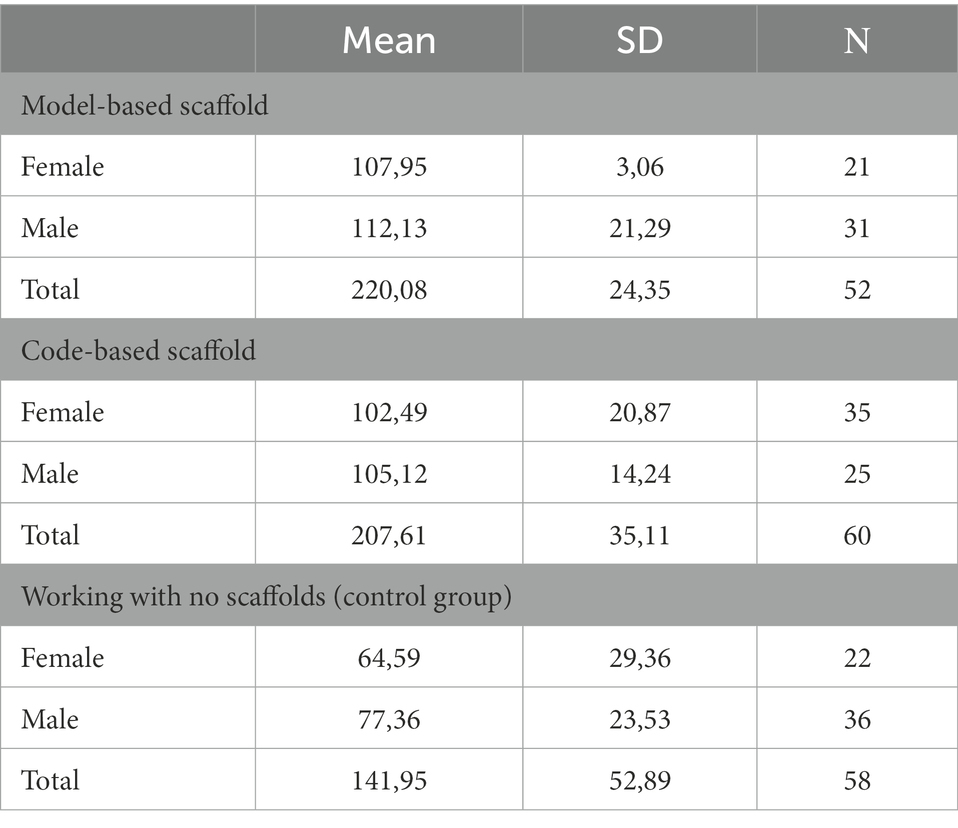
Table 7. Descriptive statistics of children’s computational thinking in Phase 2 for each scaffold and gender.
A 2 × 3 analysis of variance determined a statistically significant difference between boys and girls on the different forms of scaffolds administered in Phase 2. The results revealed that the type of scaffold [F (2, 164) = 64.60, p < 0.01] was statistically significant for the scores of computational thinking. Post-hoc comparisons showed that both model-based scaffolding and code-based scaffolding outperformed the control group, with no statistically significant differences between them. The findings did not show any other statistically significant main effect or an interaction effect between gender and type of scaffold.
During the third research phase, when the researchers withdrew the scaffolds, boys outperformed girls in all groups. According to the descriptive statistics shown in Table 8, boys in the model-based scaffolding group outperformed boys and girls in all other groups. As in Table 7, the descriptive statistics in Table 8 also show large standard deviations indicating a wide variance in the observed scores around the mean. A wide variance indicates, as before, that there are probably large differences in the individual scores among the preschool students who participated in the study.
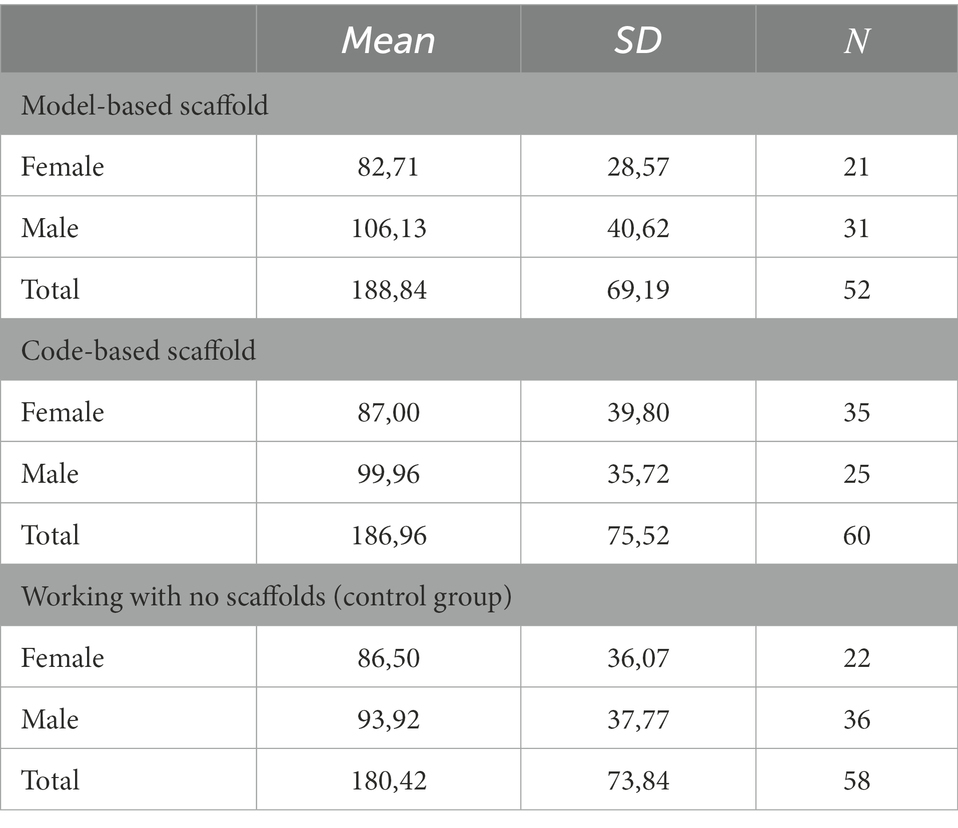
Table 8. Descriptive statistics of children’s computational thinking in Phase 3 for each scaffold and gender.
The researchers conducted a 2 × 3 analysis of variance to investigate the differences between boys and girls and the different forms of scaffolding strategies. The findings showed that gender had a significant main effect [F (1, 164) = 9.06, p < 0.01] in the computational thinking score, revealing the superiority of boys in this study. The results did not indicate any other statistically significant main effect or an interaction effect between gender and type of scaffold.
The authors also performed a 2 × 3 repeated measures analysis of variance to examine the effects of the two scaffolding techniques on boys’ and girls’ computational thinking across Phase 2 and Phase 3 of the research. The results showed statistically significant between-subject effects for type of scaffold, F (2, 164) = 11.03, p < 0.01, in favor of the model-based scaffolding in Phase 2, and gender, F (1, 164) = 10.63, p < 0.01, in favor of boys who performed at their best in Phase 3.
6. Discussion
In this study, the authors investigated whether gender differences and type of scaffold differentially affected young children’s computational thinking performance during problem-solving with a series of tasks using the robot Bee-Bot. The study’s findings clearly showed that boys outperformed girls on computational thinking performance in all study phases. The results agree with the findings of previous studies conducted in preprimary and primary education settings (e.g., Palmér, 2017; Román-González et al., 2017; Otterborn et al., 2020).
The gender differences in the development of computational thinking, as observed in the context of the study herein, might be related to the spatial ability of the participants since the majority of the study’s problem-solving tasks required the formation of sequences of commands that comprised the spatial referents “left” and “right.” Girls’ ability may explain the performance on tasks that involved the mental rotation of figures (Linn and Petersen, 1985; Voyer et al., 1995; Maeda and Yoon, 2013). The cerebral cortex influences mental rotation and is more significant in boys than girls (Bonomo, 2010). Indeed, some research has shown that males with better visual–spatial working memory are likely to perform better in visual-motor tasks than girls (Maeda and Yoon, 2013), as the results of this study also showed.
Another possible interpretation of the strong effect of gender on computational thinking, as evident in the findings of this study, might be related to the types of scaffolding tools used to develop computational thinking. The model- and code-based scaffolding tools contributed to girls’ lower performance on the problem-solving tasks than their male counterparts because they mainly emphasized visual and motor processes and not so much verbal and sensory memory processes that girls prefer (Bonomo, 2010). A different type of scaffold, including storytelling activities, might have shown different results (Kelleher et al., 2007). According to Kelleher et al. (2007), girls that had storytelling support showed more evidence of engagement with programming and expressed greater interest in the future use of coding than girls who did not have this support. Also, Angeli and Valanides (2020) showed in their study that young males learned best using manipulative-based activities during learning with a robotic device. In contrast, young females preferred and performed better with collaborative writing activities. In a study by Gomes et al. (2018) the results indicated a satisfactory understanding of sequences of instructions and conditionals but also showed challenges concerning graphical symbols, text, and interaction elements identified as complex for the children to understand, making the support of an adult fundamental. The findings showed that suitable solutions for conveying basic programming concepts to young children have not yet been found, demanding further investigation, possibly towards structured hybrid approaches combining digital games and unplugged activities.
The results from the second phase of this study showed that children in the experimental groups outperformed those in the control group who learned with no scaffolding tools. These results are consistent with contemporary work by Angeli and Valanides (2020) that showed the necessity of using scaffolding techniques, such as external memory systems, to facilitate students’ learning with robotic tools. Also, the results of the study are in line with the results of studies that outlined the necessity of scaffolding, especially for younger students during their learning with technological tools to reduce the cognitive load imposed by the device on children’s mental resources (Van Merriënboer et al., 2003; Angeli and Valanides, 2004; Azevedo and Hadwin, 2005; Myhill and Warren, 2005).
The observed low scores of the children belonging to the control group on computational thinking performance are because students encountered difficulties while trying to visualize the algorithm to solve the problem. In particular, children had problems visualizing the command sequences as they could not correctly discriminate between left and right movements (Sarama and Clements, 2009). However, as Shusterman and Spelke (2005) showed, children with appropriate scaffolding could understand and use the concept of left and right correctly, as the results of this study also show.
Lastly, the findings of this study are helpful for preschool teachers who would like to teach with robotics but lack confidence and competence (Bers et al., 2013). In addition, the study provides ideas about scaffolds and how educators can design robotics activities to promote children’s computational thinking and assess computational thinking performance.
7. Limitations and future directions
The study’s findings provide an empirical account of the effects of gender and scaffolds in developing young children’s computational thinking. In this last section of the paper, the authors address some study limitations. Firstly, the duration of the intervention was short, and as reported in the literature, longer interventions are needed to investigate the transfer of knowledge in different contexts (e.g., Bers, 2008; Bers et al., 2014). Second, future research investigations need to consider when to fade the provision of scaffolds, as scaffolds need to be gradually faded out, which may vary from student to student (Van de Pol et al., 2010). Herein, the researchers removed the scaffolds simultaneously for all students. However, learning to solve with robotics requires sustained and immersive effort (Bers et al., 2014). Thus, future interventions should be longer, personalized, and differentiated according to the individual needs of the learners.
Last but not least, more research for investigating the factors contributing to females’ full engagement in robotics activities will add value to the existing knowledge base. Gaining a better understanding and addressing the underlying causes of gender differences in young children’s computational thinking is of great importance. In addition, it will provide the research community with tools and principles for designing effective and efficient learning with robotics for both boys and girls. Future work toward these directions will advance research on computational thinking and its successful integration in classroom settings.
Data availability statement
The raw data supporting the conclusions of this article will be made available by the authors, without undue reservation.
Ethics statement
Ethical review and approval was not required for the study on human participants in accordance with the local legislation and institutional requirements. The patients/participants provided their written informed consent to participate in this study.
Author contributions
CA designed the research study and wrote the article. KG collected the data. CA and KG analyzed data. All authors contributed to the article and approved the submitted version.
Conflict of interest
The authors declare that the research was conducted in the absence of any commercial or financial relationships that could be construed as a potential conflict of interest.
Publisher’s note
All claims expressed in this article are solely those of the authors and do not necessarily represent those of their affiliated organizations, or those of the publisher, the editors and the reviewers. Any product that may be evaluated in this article, or claim that may be made by its manufacturer, is not guaranteed or endorsed by the publisher.
References
Adams Becker, S., Freeman, A., Giesinger Hall, C., Cummins, M., and Yuhnke, B. (2016). NMC/CoSN Horizon Report: 2016 K-12 Edition. Austin, Texas: The New Media Consortium.
Angeli, C., and Valanides, N. (2004). The effect of electronic scaffolding for technology integration on perceived task effort and confidence of primary student teachers. J. Res. Technol. Educ. 37, 29–43. doi: 10.1080/15391523.2004.10782424
Angeli, C., and Valanides, N. (2020). Developing young children's computational thinking with educational robotics: An interaction effect between gender and scaffolding strategy. Comput. Hum. Behav. 105:105954. doi: 10.1016/j.chb.2019.03.018
Angeli, C., Voogt, J., Fluck, A., Webb, M., Cox, M., Malyn-Smith, J., et al. (2016). A K-6 computational thinking curriculum framework: Implications for teacher knowledge. J. Educ. Technol. Soc. 19, 45–47.
Armoni, M., and Gal-Ezer, J. (2014). Early computing education: why? What? When? Who? ACM Inroads 5, 54–59. doi: 10.1145/2684721.2684734
Atmatzidou, S., and Demetriadis, S. (2016). Advancing students' computational thinking skills through educational robotics: A study on age and gender relevant differences. Robot. Auton. Syst. 75, 661–670. doi: 10.1016/j.robot.2015.10.008
Azevedo, R., and Hadwin, A. F. (2005). Scaffolding self-regulated learning and metacognition–Implications for the design of computer-based scaffolds. Instr. Sci. 33, 367–379. doi: 10.1007/s11251-005-1272-9
Barr, V., and Stephenson, C. (2011). Bringing computational thinking to K-12: what is Involved, and what is the role of the computer science education community? ACM Inroads 2, 48–54. doi: 10.1145/1929887.1929905
Basu, S. (2019). “Using rubrics integrating design and coding to assess middle school students' open-ended block-based programming projects.” in Proceedings of the 50th ACM Technical Symposium on Computer Science Education. pp. 1211–1217. ACM.
Basu, S., McElhaney, K., Grover, S., Harris, C., and Biswas, G. (2018). “A principled approach to designing assessments that integrate science and computational thinking.” in Proceedings of ICLS'18. pp.384–391. London, England: ISLS.
Belland, B. R. (2014). “Scaffolding: Definition, current debates, and future directions,” in Handbook of Research on Educational Communications and Technology. eds. J. Spector, M. Merrill, J. Elen, and M. Bishop (New York, NY: Springer), 505–518.
Belland, B. R., Weiss, D. M., Kim, N. J., Piland, J., and Gu, J. (2019). An examination of credit recovery students’ use of computer-based scaffolding in a problem-based, scientific inquiry unit. Int. J. Sci. Math. Educ. 17, 273–293. doi: 10.1007/s10763-017-9872-9
Beraza, I., Pina, A., and Demo, B. (2010). Soft & hard ideas to improve interaction with robots for Kids & Teachers. Proceedings of SIMPAR, 549–557.
Bers, M. U. (2008). Blocks, robots, and computers: Learning about Technology in early childhood. New York: Teacher's College Press.
Bers, M. U., Flannery, L., Kazakoff, E. R., and Sullivan, A. (2014). Computational thinking and tinkering: Exploration of an early childhood robotics curriculum. Comput. Educ. 72, 145–157. doi: 10.1016/j.compedu.2013.10.020
Bers, M., Seddighin, S., and Sullivan, A. (2013). Ready for robotics: Bringing together the T and E of STEM in early childhood teacher education. J. Technol. Teach. Educ. 21, 355–377.
Bers, M. U., Ponte, I., Juelich, C., Viera, A., and Schenker, J. (2002). Teachers as designers: Integrating robotics in early childhood education. Inf. Technol. Child. Educ. Annu. 2002, 123–145.
Bers, M. U., and González-González, C., & Armas–Torres, M. B. (2019). Coding as a playground: Promoting positive learning experiences in childhood classrooms. Comput. Educ., 138, 130–145, doi: 10.1016/j.compedu.2019.04.013
Bocconi, S., Chioccariello, A., Dettori, G., Ferrari, A., Engelhardt, K., Kampylis, P., et al. (2016). Developing computational thinking in compulsory education. European Commission, JRC Science for Policy Report, 68.
Bonomo, V. (2010). Gender matters in elementary education: research-based strategies to meet the distinctive learning needs of boys and girls. Educ. Horiz. 88, 257–264.
Bredekamp, S., and Copple, C. (1997). “Developmentally Appropriate Practice in Early Childhood Programs. (Revised Edition).” in National Association for the Education of Young Children, 1509 16th Street, NW, Washington, DC 20036–1426.
Brennan, K., and Resnick, M. (2012). “New frameworks for studying and assessing the development of computational thinking.” in Proceedings of the 2012 annual meeting of the American educational research association, Vancouver, Canada (Vol. 1, p. 25).
Burke, Q., and Kafai, Y. B. (2012). “The writers' workshop for youth programmers: digital storytelling with Scratch in middle school classrooms.” in Proceedings of the 43rd ACM technical symposium on Computer Science Education. pp. 433–438.
Cejka, E., Rogers, C., and Portsmore, M. (2006). Kindergarten robotics: Using robotics to motivate math, science, and engineering literacy in elementary school. Int. J. Eng. Educ. 22:711.
Cai, Z., Mao, P., Wang, D., He, J., Chen, X., and Fan, X. (2022). Effects of Scaffolding in Digital Game-Based Learning on Student’s Achievement: a Three-Level Meta-analysis. Educ. Psychol. Rev. 34, 537–574. doi: 10.1007/s10648-021-09655-0
Çetin, M., and Demircan, H. Ö. (2020). Empowering technology and engineering for STEM education through programming robots: A systematic literature review. Early Child Dev. Care. 190, 1323–1335.
Chaldi, D., and Mantzanidou, G. (2021). Educational robotics and STEAM in early childhood education. Adv. Mobile Lear. Educ. Res. 1, 72–81. doi: 10.25082/AMLER.2021.02.003
Chen, Y. S., Kao, T. C., and Sheu, J. P. (2003). A mobile learning system for scaffolding bird watching learning. J. Comput. Assist. Learn. 19, 347–359. doi: 10.1046/j.0266-4909.2003.00036.x
Ching, Y. H., Hsu, Y. C., and Baldwin, S. (2018). Developing computational thinking with educational technologies for young learners. TechTrends 62, 563–573. doi: 10.1007/s11528-018-0292-7
Clements, D. H. (1999). Subitizing: What is it? Why teach it? Teach. Child. Math. 5, 400–405. doi: 10.5951/TCM.5.7.0400
Clements, D. H., and McMillen, S. (1996). Rethinking "concrete" manipulatives. Teach. Child. Math. 2, 270–279. doi: 10.5951/TCM.2.5.0270
Cole, A. D. (2006). Scaffolding beginning readers: Micro and macro cues teachers use during student oral reading. Read. Teach. 59, 450–459. doi: 10.1598/RT.59.5.4
Critten, V., Hagon, H., and Messer, D. (2022). Can pre-school children learn programming and coding through guided play activities? A case study in computational thinking. Early Childhood Educ. J. 50, 969–981. doi: 10.1007/s10643-021-01236-8
Denning, P. J. (2017). Remaining trouble spots with computational thinking. Commun. ACM 60, 33–39. doi: 10.1145/2998438
Druin, A., Hendler, J. A., and Hendler, J. (2000). Robots for kids: Exploring new technologies for learning. New York: Morgan Kaufmann.
Duckworth, A. L., and Seligman, M. E. (2006). Self-discipline gives girls the edge: Gender in self-discipline, grades, and achievement test scores. J. Educ. Psychol. 98, 198–208. doi: 10.1037/0022-0663.98.1.198
Edwards, M. (2011). Algorithmic Composition: Computational thinking in music. Commun. ACM 54, 58–67. doi: 10.1145/1965724.1965742
Elkin, M., Sullivan, A., and Bers, M. U. (2016). Programming with the KIBO robotics kit in preschool classrooms. Comput. Sch. 33, 169–186. doi: 10.1080/07380569.2016.1216251
Falloon, G. (2016). An analysis of young students' thinking when completing basic coding tasks using Scratch Jnr. On the iPad. J. Comput. Assist. Learn. 32, 576–593. doi: 10.1111/jcal.12155
Fenson, L., and Schell, R. E. (1985). The origins of exploratory play. Early Child Dev. Care 19, 3–24. doi: 10.1080/0300443850190102
Fessakis, G., Gouli, E., and Mavroudi, E. (2013). Problem-solving by 5–6 years old kindergarten children in a computer programming environment: A case study. Comput. Educ. 63, 87–97. doi: 10.1016/j.compedu.2012.11.016
Fluck, A., Webb, M., Cox, M., Angeli, C., Malyn-Smith, J., Voogt, J., et al. (2016). Arguing for computer science in the school curriculum. J. Educ. Technol. Soc. 19, 38–46.
Genkova, P., and Schreiber, H. (2021). Accept and apply diversity? An exploratory study of the attitudes towards diversity of students of STEM subjects. SN Soc. Sci. 1, 1–22. doi: 10.1007/s43545-021-00064-2
Grover, S., and Pea, R. (2013). Computational thinking in k–12: A review of the state of the field. Educ. Res. 42, 38–43. doi: 10.3102/0013189X12463051
Gomes, T. C. S., Falcão, T. P., and Tedesco, P. C. D. A. R. (2018). Exploring an approach based on digital games for teaching programming concepts to young children. Int. J. Child-Comp. Int. 16, 77–84. doi: 10.1016/j.ijcci.2017.12.005
Guzdial, M. (2008). Education paving the way for computational thinking. Commun. ACM 51, 25–27. doi: 10.1145/1378704.1378713
Gurian, M., and Ballew, A. C. (2003). The boys and girls learn differently action guide for teachers. San Fransisco: John Wiley & Sons.
Halpern, D. F., Benbow, C. P., Geary, D. C., Gur, R. C., Hyde, J. S., and Gernsbacher, M. A. (2007). The science of sex differences in science and mathematics. Psychol. Sci. Public Interest 8, 1–51. doi: 10.1111/j.1529-1006.2007.00032.x
Henderson, S. D., Many, J. E., Wellborn, H. P., and Ward, J. (2002). How scaffolding nurtures the development of young children's literacy repertoire: Insiders' and outsiders' collaborative understandings. Read. Res. Instr. 41, 309–330. doi: 10.1080/19388070209558374
Highfield, K. (2014). “Stepping into STEM with young children: Simple robotics and programming as catalysts for early learning” in In technology and digital media in the early years (Routledge), 182–193.
Hubwieser, P., and Aiglstorfer, G. (2009). “16 Die Pseudo-Programmiersprachen PPS und FPPS” in Fundamente der Informatik (München: Oldenbourg Wissenschaftsverlag), 265–270.
Hogan, K. E., and Pressley, M. E. (1997). Scaffolding student learning: Instructional approaches and issues. Boston, MA: Brookline Books.
Horn, M. S., Crouser, R. J., and Bers, M. U. (2012). Tangible interaction and learning: The case for a hybrid approach [Electronic version]. Pers. Ubiquit. Comput. 16, 379–389. doi: 10.1007/s00779-011-0404-2
Horn, M. S., and Jacob, R. J. (2006). “Tangible programming in the classroom: a practical approach.” in CHI'06 extended abstracts on Human factors in computing systems. 869–874.
Jung, S. E., and Won, E. S. (2018). Systematic review of research trends in robotics education for young children. Sustainability 10:905. doi: 10.3390/su10040905
Kalelioglu, F., Gülbahar, Y., and Kukul, V. (2016). A framework for computational thinking based on a systematic research review. Baltic J. Modern Comp. 4, 583–596.
Kazakoff, E. R., Sullivan, A., and Bers, M. U. (2013). The effect of a classroom-based intensive robotics and programming workshop on sequencing ability in early childhood. Early Childhood Educ. J. 41, 245–255. doi: 10.1007/s10643-012-0554-5
Kelleher, C., Pausch, R., Pausch, R., and Kiesler, S. (2007). “Storytelling Alice motivates middle school girls to learn computer programming.” in Proceedings of the SIGCHI conference on Human factors in computing systems. pp. 1455–1464. ACM.
Kim, C., Kim, D., Yuan, J., Hill, R. B., Doshi, P., and Thai, C. N. (2015). Robotics to promote elementary education pre-service teachers' STEM engagement, learning, and teaching. Comput. Educ. 91, 14–31. doi: 10.1016/j.compedu.2015.08.005
Kim, N. J., Belland, B. R., and Walker, A. E. (2018). Effectiveness of computer-based scaffolding in the context of problem-based learning for STEM education: Bayesian meta-analysis. Educ. Psychol. Rev. 30, 397–429. doi: 10.1007/s10648-017-9419-1
Linn, M. C., and Petersen, A. C. (1985). Emergence and characterization of sex differences in spatial ability: A meta-analysis. Child Dev. 56, 1479–1498. doi: 10.2307/1130467
Liu, Z. Y., Chubarkova, E., and Kharakhordina, M. (2020). Online technologies in STEM education. iJET 15, 20–32. doi: 10.3991/ijet.v15i15.14677
Livingstone, S. (2016). New' screen time rules from the American Academy of Pediatrics. Parenting for a Digital Future.
Lye, S. Y., and Koh, J. H. L. (2014). Review on teaching and learning of computational thinking through programming: What is next for K-12? Comput. Hum. Behav. 41, 51–61. doi: 10.1016/j.chb.2014.09.012
Macrides, E., Miliou, O., and Angeli, C. (2022). Programming in early childhood education: A systematic review. Int. J. Child-Comput. Interact. 32:100396. doi: 10.1016/j.ijcci.2021.100396
Maeda, Y., and Yoon, S. Y. (2013). A meta-analysis on gender differences in mental rotation ability measured by the Purdue spatial visualization tests: Visualization of Rotations (PSVT: R). Educ. Psychol. Rev. 25, 69–94. doi: 10.1007/s10648-012-9215-x
Mashburn, A. J., Justice, L. M., Downer, J. T., and Pianta, R. C. (2009). Peer effects on children's language achievement during pre-kindergarten. Child Dev. 80, 686–702. doi: 10.1111/j.1467-8624.2009.01291.x
Misirli, A., and Komis, V. (2014). “Robotics and programming concepts in Early Childhood Education: A conceptual framework for designing educational scenarios,” in Research on e-Learning and ICT in Education. eds. C. Karagiannidis, P. Politis, and I. Karasavvidis (New York, NY: Springer), 99–118.
Myhill, D., and Warren, P. (2005). Scaffolds or straitjackets? Critical moments in classroom discourse. Educ. Rev. 57, 55–69. doi: 10.1080/0013191042000274187
Nouri, J., Zhang, L., Mannila, L., and Norén, E. (2020). Development of computational thinking, digital competence, and 21st century skills when learning programming in K-9. Educ. Inq. 11, 1–17. doi: 10.1080/20004508.2019.1627844
Otterborn, A., Schönborn, K. J., and Hultén, M. (2020). Investigating preschool educators’ implementation of computer programming in their teaching practice. Early Childhood Educ. J. 48, 253–262. doi: 10.1007/s10643-019-00976-y
Palmér, H. (2017). Programming in Preschool--With a Focus on Learning Mathematics. Int. Res. Early Childh. Educ. 8, 75–87.
Papadakis, S., Kalogiannakis, M., and Zaranis, N. (2017). Improving mathematics teaching in kindergarten with realistic mathematical education. Early Childhood Educ. J. 45, 369–378. doi: 10.1007/s10643-015-0768-4
Papadakis, S. (2020). Evaluating a game-development approach to teach introductory programming concepts in secondary education. Int. J. Tech. Enhan. Lear. 12, 127–145. doi: 10.1504/IJTEL.2020.106282
Papert, S. (1993). The children's machine: Rethinking school in the age of the computer. New York, NY: Basic Books.
Pawan, F. (2008). Content-area teachers and scaffolded instruction for English language learners. Teach. Teach. Educ. 24, 1450–1462. doi: 10.1016/j.tate.2008.02.003
Pomerantz, E. M., Altermatt, E. R., and Saxon, J. L. (2002). Making the grade but feeling distressed: Gender differences in academic performance and internal distress. J. Educ. Psychol. 94, 396–404. doi: 10.1037/0022-0663.94.2.396
Pugnali, A., Sullivan, A., and Bers, M. U. (2017). The impact of user interface on young children’s computational thinking. J. Inform. Tech. Educ. Innov. Pract. 16, 171–193. doi: 10.28945/3768
Puntambekar, S., and Hubscher, R. (2005). Tools for scaffolding students in a complex learning environment: What have we gained and what have we missed? Educ. Psychol. 40, 1–12. doi: 10.1207/s15326985ep4001_1
Puntambekar, S., and Kolodner, J. L. (2005). Toward implementing distributed scaffolding: Helping students learn science from design. J. Res. Sci. Teach. 42, 185–217.
Reges, S. (2006). “Back to basics in CS1 and CS2.” in Proceedings of the 37th SIGCSE technical symposium on Computer science education. pp. 293–297.
Reid-Griffin, A., and Carter, G. (2004). Technology as a tool: Applying an instructional model to teach middle school students to use technology as a mediator of learning. J. Sci. Educ. Technol. 13, 495–504. doi: 10.1007/s10956-004-1470-2
Resnick, M., Myers, B., Nakakoji, K., Shneiderman, B., Pausch, R., Selker, T., et al. (2005). Design principles for tools to support creative thinking. Available at: https://www.researchgate.net/publication/250022868_Design_Principles_for_Tools_to_Support_Creative_Thinking
Resnick, M. (1995). “New paradigms for computing, new paradigms for thinking,” in Computers and Exploratory Learning, eds. A. diSessa, C. Hoyles, and R. Noss (Berlin, Heidelberg: Springer), 31–43.
Rodgers, E. M. (2005). Interactions that scaffold reading performance. J. Lit. Res. 36, 501–532. doi: 10.1207/s15548430jlr3604_4
Román-González, M., Pérez-González, J. C., and Jiménez-Fernández, C. (2017). Which cognitive abilities underlie computational thinking? Criterion validity of the Computational Thinking Test. Comput. Hum. Behav. 72, 678–691. doi: 10.1016/j.chb.2016.08.047
Román-González, M., Pérez-González, J. C., Moreno-León, J., and Robles, G. (2018). Extending the nomological network of computational thinking with non-cognitive factors. Comput. Hum. Behav. 80, 441–459. doi: 10.1016/j.chb.2017.09.030
Sarama, J., and Clements, D. H. (2009). Early childhood mathematics education research: Learning trajectories for young children. New York, NY: Routledge.
Sengupta, P., Kinnebrew, J. S., Basu, S., Biswas, G., and Clark, D. (2013). Integrating computational thinking with K-12 science education using agent-based computation: A theoretical framework. Educ. Inf. Technol. 18, 351–380. doi: 10.1007/s10639-012-9240-x
Sherman, M., and Martin, F. (2015). The assessment of mobile computational thinking. J. Comput. Sci. Coll. 30, 53–59.
Shusterman, A., and Spelke, E. S. (2005). “Language and the development of spatial reasoning,” in The innate mind: Structure and contents. eds. P. Carruthers, S. Laurence, and S. Stich (Oxford University Press), 89–106.
Singer, D. G., and Singer, J. L. (2005). Imagination and play in the electronic age. Cambridge, MA: Harvard University Press.
Smith, S., and Burrow, L. E. (2016). Programming multimedia stories in Scratch to integrate computational thinking and writing with elementary students. J. Math. Educ. 9, 119–131.
Sousa, D. A., and Tomlinson, C. A. (2011). Differentiation and the brain: How neuroscience supports the learner friendly classroom. Bloomington, IN: Solution Tree.
Sullivan, A., and Bers, M. U. (2013). Gender differences in kindergarteners' robotics and programming achievement. Int. J. Technol. Des. Educ. 23, 691–702. doi: 10.1007/s10798-012-9210-z
Tabak, I. (2004). Synergy: A complement to emerging patterns of distributed scaffolding. J. Learn. Sci. 13, 305–335. doi: 10.1207/s15327809jls1303_3
Tawfik, A. A., Law, V., Ge, X., Xing, W., and Kim, K. (2018). The effect of sustained vs. faded scaffolding on students’ argumentation in ill-structured problem solving. Comput. Hum. Behav. 87, 436–449. doi: 10.1016/j.chb.2018.01.035
Van de Pol, J., Volman, M., and Beishuizen, J. (2010). Scaffolding in teacher-student interaction: A decade of research. Educ. Psychol. Rev. 22, 271–296. doi: 10.1007/s10648-010-9127-6
Van Merriënboer, J. J., Kirschner, P. A., and Kester, L. (2003). Taking the load off a learner's mind: Instructional design for complex learning. Educ. Psychol. 38, 5–13. doi: 10.1207/S15326985EP3801_2
Vidakis, N., Barianos, A. K., Trampas, A. M., Papadakis, S., Kalogiannakis, M., and Vassilakis, K. (2019). “In-game raw data collection and visualization in the context of the “ThimelEdu” educational game.” in International Conference on Computer Supported Education. pp. 629–646. Springer.
Voyer, D., Voyer, S., and Bryden, M. P. (1995). Magnitude of sex differences in spatial abilities: A meta-analysis and consideration of critical variables. Psychol. Bull. 117, 250–270. doi: 10.1037/0033-2909.117.2.250
Weinberg, A. E. (2013). Computational thinking: An investigation of the existing scholarship and research (Doctoral dissertation, Colorado State University).
Weintrop, D., Beheshti, E., Horn, M., Orton, K., Jona, K., Trouille, L., et al. (2016). Defining computational thinking for mathematics and science classrooms. J. Sci. Educ. Technol. 25, 127–147. doi: 10.1007/s10956-015-9581-5
Wyeth, G. (2008). “Demonstrating the safety and performance of a velocity sourced series elastic actuator.” in 2008 IEEE International Conference on Robotics and Automation. (IEEE), 3642–3647.
Wilensky, U., Brady, C. E., and Horn, M. S. (2014). Fostering computational literacy in science classrooms. Commun. ACM 57, 24–28. doi: 10.1145/2633031
Wing, J. M. (2011). Research notebook: Computational thinking—What and why. The Link Magazine, 20–23.
Wing, J. M. (2008). Computational thinking and thinking about computing. Philos. Trans. R. Soc. A Math. Phys. Eng. Sci. 366, 3717–3725. doi: 10.1098/rsta.2008.0118
Wood, D., Bruner, J. S., and Ross, G. (1976). The role of tutoring in problem solving. J. Child Psychol. Psychiatry 17, 89–100. doi: 10.1111/j.1469-7610.1976.tb00381.x
Keywords: computational thinking, scaffolding tools, gender, young children, robotics
Citation: Angeli C and Georgiou K (2023) Investigating the effects of gender and scaffolding in developing preschool children’s computational thinking during problem-solving with Bee-Bots. Front. Educ. 7:757627. doi: 10.3389/feduc.2022.757627
Edited by:
Nam Ju Kim, University of Miami, United StatesReviewed by:
Soumela Atmatzidou, Aristotle University of Thessaloniki, GreeceValerie Critten, The Open University, United Kingdom
Jeremy Winters, Middle Tennessee State University, United States
Copyright © 2023 Angeli and Georgiou. This is an open-access article distributed under the terms of the Creative Commons Attribution License (CC BY). The use, distribution or reproduction in other forums is permitted, provided the original author(s) and the copyright owner(s) are credited and that the original publication in this journal is cited, in accordance with accepted academic practice. No use, distribution or reproduction is permitted which does not comply with these terms.
*Correspondence: Charoula Angeli, ✉ Y2FuZ2VsaUB1Y3kuYWMuY3k=; Kyriakoula Georgiou, ✉ Z2Vvcmdpb3Uua3lyaWFrb3VsYUB1Y3kuYWMuY3k=
 Charoula Angeli
Charoula Angeli Kyriakoula Georgiou*
Kyriakoula Georgiou*
